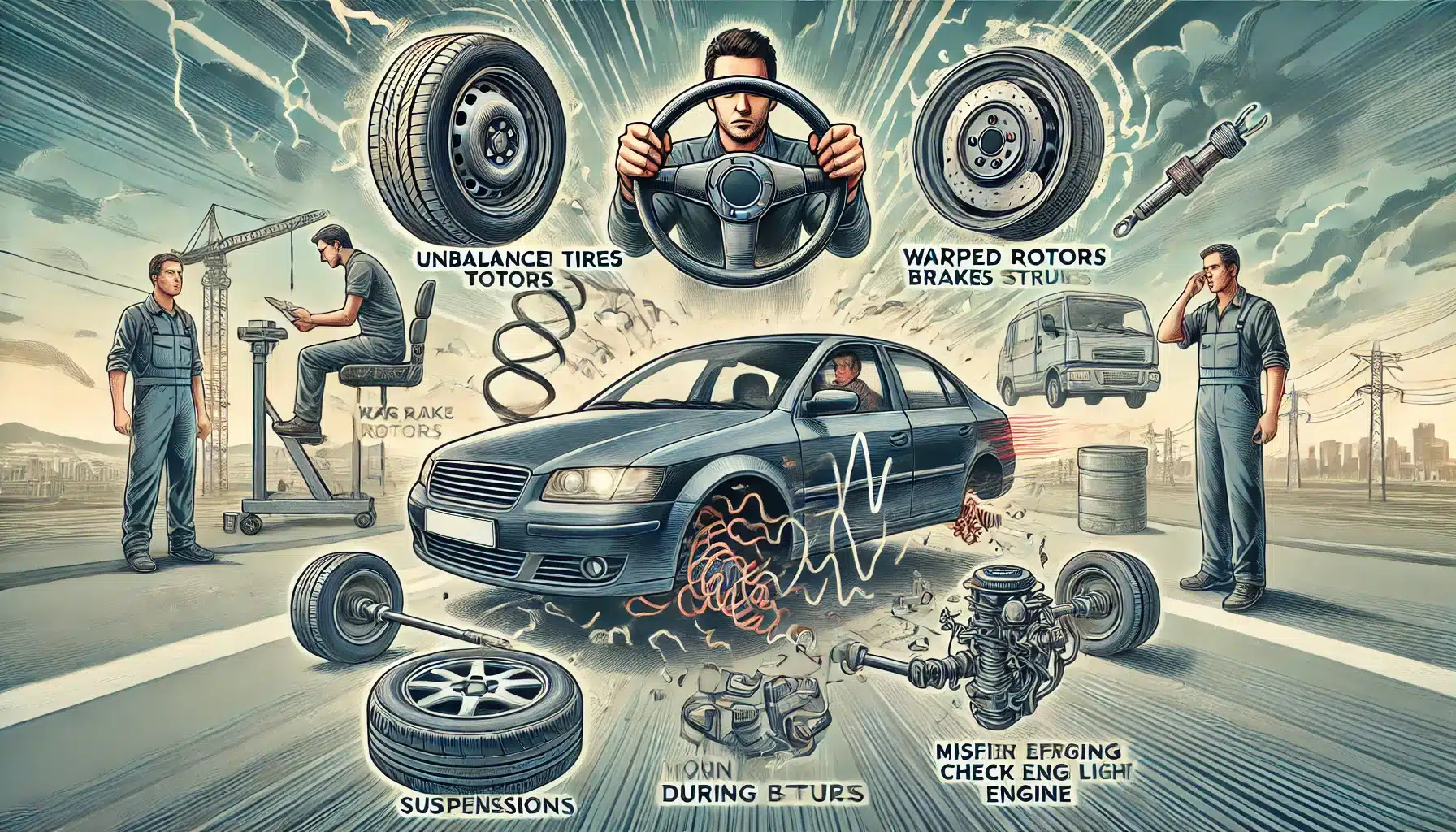Why is my car shaking?

If your car is shaking, it could stem from several potential causes, and the specific situation in which the shaking occurs can provide clues. One common reason for a car to shake is an issue with the wheels or tires. For example, if a tire is out of balance, it can cause vibrations that intensify as the vehicle increases speed. This is often felt through the steering wheel and may occur around specific speed ranges. Uneven tire wear, a bent rim, or under-inflated tires can also lead to a rough ride and vibrations.
You can tell if your tires are not balanced if you experience vibrations, particularly at higher speeds, usually between 50 to 70 mph. These vibrations may be felt through the steering wheel, seats, or floor of the vehicle. If the shaking is coming from the front of the car, it’s more likely a sign of unbalanced front tires, while vibrations from the rear suggest an issue with the rear tires. Uneven tire wear is another sign, as unbalanced tires can cause certain areas of the tire to wear down faster than others. Lastly, a humming or buzzing noise at highway speeds may accompany these vibrations.
Another potential cause of shaking, especially if it occurs while braking, is an issue with the brake system. Warped brake rotors, for instance, can cause pulsations when you apply the brakes, as the uneven surface of the rotor leads to inconsistent friction with the brake pads. This is often felt in the steering wheel or through the brake pedal. If the shaking is accompanied by squealing noises, it could indicate worn brake pads or other brake components needing replacement.
You can tell if you have warped brake rotors if you feel a pulsating or vibrating sensation through the brake pedal when applying the brakes, especially at higher speeds. This pulsation is caused by the uneven surface of the rotors interacting with the brake pads. Additionally, you might hear a squeaking or scraping noise while braking. In more severe cases, the steering wheel may also shake or vibrate when you apply the brakes, indicating the front rotors are affected. Warped rotors can also result in longer stopping distances or uneven braking performance
Suspension and alignment issues are also culprits behind a shaking car. Worn or damaged suspension components, such as control arms, bushings, or shocks, can cause instability, particularly at higher speeds or when going over bumps. If the car feels like it’s bouncing excessively or pulling to one side, a suspension issue or improper alignment may be the cause.
You can tell if you have worn or damaged suspension components if you experience a rough or bouncy ride, especially when going over bumps or uneven roads. The car may feel unstable or drift to one side while driving, indicating poor alignment or suspension issues. You might also hear unusual noises like clunking or squeaking when driving over bumps or turning. Uneven tire wear or excessive dipping of the front end when braking can also be signs of worn shocks or struts. Additionally, if the car feels like it’s swaying or leaning more than usual during turns, it’s a strong indicator of suspension problems.
In some cases, the engine itself may be the source of the shaking. Misfiring cylinders, which occur when the engine’s combustion process is disrupted, can cause the car to shudder, especially at idle or when accelerating. This can be due to a range of problems, such as faulty spark plugs, clogged fuel injectors, or ignition system issues. If the check engine light comes on, it’s a good indication that the problem may lie within the engine or its related systems.
You can tell if you have misfiring cylinders if your car exhibits symptoms like rough idling or jerking, especially during acceleration. The engine may hesitate or feel sluggish when you press the gas pedal, and there can be a noticeable drop in power. Often, the check engine light will turn on, indicating a misfire. Additionally, you might hear unusual sounds like sputtering or popping from the engine, and there could be an increase in exhaust emissions or a strong fuel smell.
Finally, the driveline, which includes components such as the driveshaft, CV joints, and axles, can also contribute to shaking, particularly when accelerating. If any part of the driveline is damaged, worn, or out of alignment, it can create vibrations that travel through the vehicle. For instance, a worn CV joint can cause vibrations when turning or accelerating, while issues with the driveshaft can lead to shaking when driving at higher speeds.
You can tell if you have problems with your driveline if you experience vibrations or shaking that worsen during acceleration or at higher speeds. A clunking or clicking noise, especially when shifting gears or making turns, can indicate issues with the driveshaft or CV joints. Additionally, you might feel a loss of power or difficulty controlling the vehicle, especially in rear-wheel or all-wheel-drive cars. If the driveline problem is severe, you may notice a delay or jerking when shifting from park to drive or reverse.
Ultimately, diagnosing the cause of your car’s shaking requires a closer inspection of the tires, brakes, suspension, engine, and driveline, or consulting a professional mechanic who can pinpoint the issue accurately.
ChatGPT
Writer
ChatGPT is a large language model developed by OpenAI, based on the GPT-3.5 architecture. It was trained on a massive amount of text data, allowing it to generate human-like responses to a wide variety of prompts and questions. ChatGPT can understand and respond to natural language, making it a valuable tool for tasks such as language translation, content creation, and customer service. While ChatGPT is not a sentient being and does not possess consciousness, its sophisticated algorithms allow it to generate text that is often indistinguishable from that of a human.
